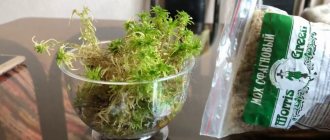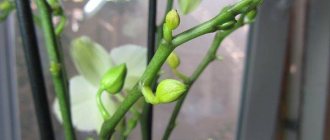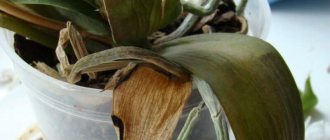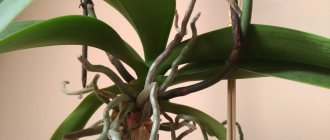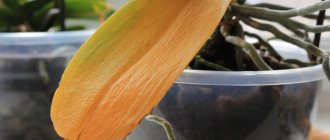Sometimes it can be observed that the substrate in the pot with the orchid has turned green. The reason for this is the bark that is part of the soil mixture.
It contains nutritional elements that serve as food for microorganisms, mosses and algae.
These satellites are not always useful to the orchid, so it is worth understanding why they appear and what to do in this case.
Below we will tell you about interesting facts about how green moss appears in an orchid pot.
The appearance of green moss in an orchid pot
The green coating that forms on the inside of the transparent pot is nothing more than algae. For their development it is necessary :
- Warm;
- Light;
- Humidity.
Green moss on the orchid appears in the warm season.
The combination of these factors can lead to :
- Mass proliferation of algae;
- Greening : Substrate;
- Roots;
- And the walls of the pot.
A similar situation occurs in small bodies of water in the summer and manifests itself in the form of algae blooms.
Causes
Why is the ground covered with moss in an orchid? Factors that lead to the growth of algae or moss in the soil are often caused by improper plant care :
- If the orchid is planted in a pot that is too large;
- Has a substrate that has compacted over time;
- Watering too often or too much.
Sometimes the plant looks healthy, in which case it is not touched. to take action if :
- The appearance of wilting leaves;
- Poor plant growth;
- A small number of roots.
If a green coating is found inside the pot, the orchid should be replanted .
Lighting
Under the influence of sunlight, photosynthesis occurs in the cells of green algae, so a green coating in pots is formed, as a rule, during the warm period - from the beginning of May to the end of summer. The side of the pot facing the room is covered with a green coating to a lesser extent. than the one facing the sun. Therefore, it is necessary to create the right lighting for the orchid.
Wet substrate
In addition to light, a prerequisite for the development of algae and moss in an orchid pot is high humidity..
Moss in a pot with an orchid forms at high humidity.
This usually happens in a pot with an orchid that grows :
- In a clear plastic pot and clear planter;
- In a transparent pot without drainage holes.
At the same time, the soil remains wet for a long time.
Watering the soil with special means
The market for care products for indoor plants is replete with various antiseptic drugs. Their effectiveness in some cases is very questionable, but time-tested potassium permanganate has saved more than one collection of plants when mold appeared in pots.
Potassium permanganate is a chemical compound of potassium permanganate, due to which it not only perfectly kills various types of spores, but also saturates plants with the necessary potassium, which is especially needed by young and immature flowers. The use of potassium permanganate in the fight against mold is not only not dangerous for flowers, but also useful.
To combat the fungus using potassium permanganate, it is also necessary to remove the top layer of the affected soil and add fresh soil. The dried soil should be spilled with a solution diluted to a pink color and left until the soil dries completely. The procedure should not be repeated more than once a month.
If the mold has reached the roots of the plant and affected the entire earthen ball, then drastic measures should be taken. To do this, it is necessary to completely change the affected soil, wash the roots of the plant first in warm water, and then in a light pink solution of potassium permanganate. You should not dilute it to a saturated shade, since such a strong solution can burn the roots.
Some indoor plants can hardly tolerate a spill of potassium permanganate. Cyperus, hydrangea, dieffenbachia, poinsettia, various types of ferns and begonia should be shed with this solution only if absolutely necessary. For such plants, citric acid is more suitable. It is a more delicate, but no less effective antiseptic. Also, a solution of citric acid can be regularly used as a preventive measure for fungal diseases and plant rot.
What is the danger of the phenomenon?
Algae are not parasites, so they do not pose a danger to the orchid. But, in some cases, they cover the bottom with a dense layer and accumulate on the inner walls of the pot, making it difficult for air circulation in the soil and the breathing of roots.
Important! The appearance of moss or green algae indicates violations in the care and maintenance of the orchid.
Such a plant needs urgent adjustment of its care regimen .
Where does mold on flowers come from?
Anyone who has anything to do with indoor plants has had to deal with a white or yellowish coating on the walls of the pot. It is this plaque that is the initial stage of mold development.
The most vulnerable to fungal diseases are plants that are not very demanding when it comes to watering and that cannot absorb a large amount of liquid at once. Among such plants, we highlight cacti, succulents, violets and others.
There are not so many varieties of fungi that are dangerous to plants.
Types of mold:
- White mold is exactly that white coating that collects on the walls of the pot. Over time, it becomes more and more voluminous, and in the later stages of development it resembles a fluffy blanket. Often, white mold is confused with mineral deposits, but the fungus feels softer and thinner to the touch.
- Blue mold - bluish fungal microorganisms prefer wood, so they pose the greatest danger to indoor trees, wooden flower pots and plant pots.
- Black mold is the most dangerous type, which poses a threat not only to plants, but also to people. Black fungus is difficult to notice on the soil, but mold accumulated on the walls of the pot immediately catches the eye. Black mold closely resembles soil and this often leads to confusion. But, unlike soil, mold is very difficult to wash off - even after treatment with a strong detergent, ingrained traces of fungus will certainly remain on the surface.
It is worth noting that all types of mold belong to the same family, so the reasons for its appearance in each case are approximately the same:
- Contaminated soil is the most common cause, but at the same time, the most common. Often, purchased substrate is already contaminated with fungal microorganisms. A similar situation may occur with the soil that you dug up near your house. Therefore, it is best to purchase mold-resistant substrate and only from certified manufacturers;
- High intensity of watering - some types of plantings are not able to immediately absorb a large amount of liquid, and frequent watering creates discomfort for them. Plants do not have time to absorb all the moisture, and their lower leaves, as well as the stem, begin to rot, which leads to the appearance of mold;
- Increased air humidity - if you have streamlined the watering regime, but the plants still rot, pay attention to the air humidity indicator. High humidity conditions are well suited for tropical plantings, but for most of our species they are far from optimal. Excessively humid air leads to withering of plants and the appearance of fungal microorganisms.
- Poor drainage – often the appearance of fungus is associated with poor pot layout. Any container in which a flower grows must have a drainage hole and a tray to drain excess water. Experienced gardeners advise creating a drainage layer of expanded clay or pebbles at the bottom of the pot. It is very important that the soil has a structure suitable for the plant. Therefore, it is better to buy a ready-made substrate intended for a specific type of planting. Experts recommend minimizing the use of clay soil, as it strongly retains liquid, which often leads to mold.
Danger of mold
It's no secret that human fungal diseases are very difficult to treat. The situation is similar with diseases of domestic plants. Mold growth leads to:
- Deterioration of the soil - the quality of the substrate infected with the fungus noticeably decreases. Fungal microorganisms disrupt water and mineral metabolism, and also change the chemical composition of the soil, which becomes unsuitable for growing cultivated plants.
- Plant death - mold, in the later stages of development, becomes covered with a crust that retains water and does not allow air to pass through. The roots of the plant do not receive the necessary substances, and they are constantly in water. And that's why they start to rot. Immediately after the rotting process begins to spread to the stem and leaves, the plant dies.
- Infection of the premises - this is especially true for black mold. Fungal microorganisms can spread to the windowsill, walls and ceiling. Black mold is very dangerous, especially if children, old people or people with allergies live in the room.
Ways to fight
It is worth assessing the condition of the orchid - if the plant is healthy, actively growing roots and leaf mass, and the bark in the substrate is in good condition, it does not need replanting .
In this case, it is enough to reduce watering and remove the orchid from bright sun to a shaded place.
To combat green moss or algae:
- The pot with the plant is wrapped in any opaque material, for example, in foil;
- Place the flower pot in a dark, opaque pot.
This will reduce illumination and, accordingly, reduce the photosynthetic activity of algae. After some time, the green coating will disappear. If the orchid is in a pot, it is important to ensure that water does not stagnate in it.
Chemicals and antiseptics: how to treat?
Of the variety of chemicals intended for the treatment of orchids, the following are especially popular:
To reduce the risk of various diseases in orchids, it will be quite enough to provide the plants with timely and proper care, as well as suitable housing conditions.
MORE ABOUT ORCHID CARE:
Source
When is a transplant required?
If moss or algae multiply too much, the walls of the pot darken, and this can have a negative impact on the condition of the orchid, since mosses and algae clog the space between the roots and compact the substrate, depriving the roots of access to oxygen.
Such a plant needs to be transplanted into new soil after preliminary washing of the root system:
- The orchid is removed from the pot and freed from the substrate;
- The roots are washed several times in a solution of potassium permanganate (0.1%) or sodium chloride (1.0-1.5%);
- The plant is transplanted into a new, prepared substrate.
When replanting an orchid, wash the roots.
After transplantation, it is important to adjust the watering regime and the conditions for keeping the orchid.
Process technology
It is very important to choose the appropriate composition of the soil mixture, which takes into account the conditions in which the orchid will grow:
- For rooms with dry air, a third of the volume of the substrate should be occupied by a moisture-intensive component - sphagnum moss;
- In conditions of high or moderate humidity, add a minimal amount of sphagnum moss.
You can independently prepare a soil mixture suitable for specific conditions:
- Composition No. 1 , which includes charcoal and pine bark (1:5), is characterized by low moisture capacity and is optimal for growing orchids in a greenhouse;
- Composition No. 2 of charcoal, moss and pine bark cut into pieces (1:2:5) is suitable for planting orchids in baskets or pots;
- Composition No. 3 , containing pine bark with charcoal, moss and crushed polystyrene foam (5:1:1:1). This substrate has good moisture holding capacity and is best used in rooms with low humidity.
The bark is pre -boiled in water for an hour and then dried.
Advice! An incorrectly selected fertilizer composition may be a factor due to which the orchid does not form a peduncle. Thus, excessive application of nitrogen causes an increase in root mass and leaves, phosphorus stimulates the formation of a peduncle.
You need to feed the orchid only with special fertilizers with a low nitrogen content. The ratio of nitrogen, potassium and phosphorus 2:6:6 is optimal for stimulating orchid flowering.
What if the orchid is dormant?
If the orchid is in a dormant state, which, as a rule, occurs in the autumn-winter period, replanting the orchid is not recommended . At this time, all plant growth processes are very slow.
If the orchid is at rest, then it is better not to replant.
Also, you should not replant an orchid in the hot summer , when the orchid is stressed by high temperatures.
Important! An exception is made only if the plant's leaves or root system are damaged as a result.
If the plant is in the dormant phase:
- It is better to wait for the start of growth, when the plant produces a new leaf or new bulbs;
- Before transplanting, it is worth adjusting the frequency and abundance of watering, leaving 2-3 dry days between waterings.
This measure will not save you from green mosses and algae in the substrate, but will help stabilize the condition of the orchid before replanting.
White mold (Mucor)
Mold fungi grow and multiply on the surface of the soil, food products, and organic waste.
Some Mucor species are capable of causing human disease. And some species are used to produce antibiotics.
White mold on the soil in a pot does not bring any benefit; on the contrary, it can be dangerous. In appearance, it resembles white fluff, gradually filling the soil surface. To the touch, the structure is soft, easily crushed with your fingers.
It negatively affects the well-being of people and plants. Mucor will not cause any significant harm to most healthy people. But during sporulation, microscopic fungal spores entering the respiratory tract can cause an allergic reaction.
It is not so much the mold itself that harms a house plant, but the conditions under which it develops. It appeared because the rules for keeping flowers were violated.
Favorable conditions for spore germination, such as high humidity at low temperatures, heavy soils, negatively affect the development of crops. Therefore, the appearance of Mucor is not the cause of the depressed state of the plant, but a result that signals a deterioration in conditions.
Methods of disposal
In order to eliminate fungus in flower pots, the following measures must be taken:
- Replace the top layer of soil, approximately 2 - 3 cm deep, with fresh soil of a lighter structure.
- Reduce the number of waterings.
- Prevent water stagnation.
- Provide drainage.
- Loosening will saturate the soil with oxygen.
- Antifungal drugs - fungicides. For medicinal as well as preventive purposes, the ground is periodically watered with a solution of Fitosporin. It is absolutely safe, as it is a remedy for mold of biological origin.

